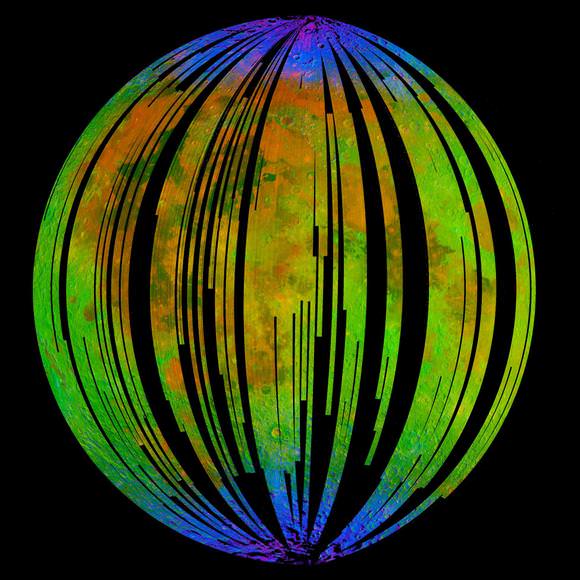[/caption]
The recent discovery of water on the Moon may have a serious impact on future plans for lunar based astronomy. Space scientists from the Chinese Academy of Sciences have calculated that the scattering caused by molecules vaporized in sunlight could heavily distort observations from telescopes mounted on the Moon.
“Last year, scientists discovered a fine dew of water covering the Moon. This water vaporizes in sunlight and is then broken down by ultraviolet radiation, forming hydrogen and hydroxyl molecules. We recalculated the amount of hydroxyl molecules that would be present in the lunar atmosphere and found that it could be two or three orders higher than previously thought,” said Zhao Hua, who presented his team’s results at the European Planetary Science Congress in Rome.
The research has particular implications for the Chinese Lunar lander, Chang’E-3, which is planned to be launched in 2013. An ultraviolet astronomical telescope will be installed on the Chang’E-3 lander, which will operate on the sunlit surface of the Moon, powered by solar panels.
“At certain ultraviolet wavelengths, hydroxyl molecules cause a particular kind of scattering where photons are absorbed and rapidly re-emitted. Our calculations suggest that this scattering will contaminate observations by sunlit telescopes,” said Zhao.
The Moon’s potential as a site for building astronomical observatories has been discussed since the era of the Space Race. Lunar-based telescopes could have several advantages over astronomical telescopes on Earth, including a cloudless sky and low seisimic activity.
The far-side of the Moon could be an ideal site for radio astronomy, being permanently shielded from interference from the Earth. Radio observations would not be affected by the higher hydroxyl levels.


Sunlit telescopes seemed like a bad idea anyway. So now you have “observational interruptus” during daytime (unless you place the scopes in persistently shadowed craters – which I guess will cover only parts of the sky).
The radical solution is to drag a NEO to a convenient orbit and place the scopes there – less atmosphere, less seismics. Another NEO research win!?
Usually nobody runs a telescope during daytime, and this habit should also apply for telecopes installed on the moon. So, you use solar panels to charge batteries during the moon´s long sunny period, and then run the telescope with these batteries during the moon´s long cold starry night.
Usually nobody runs a telescope during daytime, and this practice should also apply for telecopes installed on the moon. So, you use solar panels to charge batteries during the moon´s long hot sunny period, and then run the telescope on these batteries during the moon´s long cold starry night.
I would be more concerned about electrostatic levitation of Moon dust, due to solar ultraviolet and X-ray radiation knocking electrons out of atoms and molecules in the lunar regolith, messing up optical telescopes on the Moon.
In the early 1960s before Apollo 11, Surveyor 7 and several subsequent Surveyor spacecraft, which had soft-landed on the Moon, returned photographs showing an unmistakable twilight glow low over the lunar horizon persisting after the Sun had set. Also, the photographs showed that the Moon’s distant horizon, between the land and the sky, did not look razor-sharp — as would have been expected in a vacuum where there was no atmospheric haze.
Furthermore, Apollo 17 astronauts orbiting the Moon in 1972 had repeatedly saw and sketched what they had variously called “bands”, “streamers” or “twilight rays” lasting for about 10 seconds before lunar sunrise or after lunar sunset. Such rays were also reported by astronauts aboard Apollo 8, 10, and 15.
More information about that can be found here.
GBendt, excellent suggestion, but I suspect it’s a practice proponents did not expect to pursue. Half the ROI (roughly, surely _some_ observation can continue) and no non-interrupted observations is a heavy cost.
These findings surely can’t be good news for proponents of lunar liquid mirror telescopes: http://science.nasa.gov/science-news/science-at-nasa/2008/09oct_liquidmirror/
Proposed LLMTs already have number of technical and engineering challenges (among other problems), with dust being a primary environmental concern.
WRT UV astronomy from the lunar surface, Apollo 16 carried a small 3″ aperture telescope that photographed several targets in UV from the lunar surface (the scope was placed in the shadow of the LM).
A 2006 paper by Roger Angel et al has a more detailed look at the challenges and potential benefits of a large liquid mirror telescope located at the lunar poles: http://www.optics.arizona.edu/loft/Publications/Papers/Burge/Angel%20Proc%20SPIE%206265.pdf
Although this proposed telescope would be used in the infrared, lunar atmospheric hydroxls might still be a problem (as it is here on earth for certain IR observations).